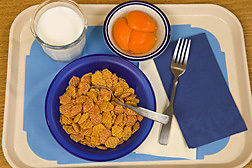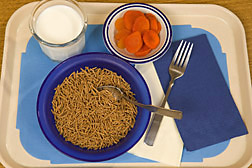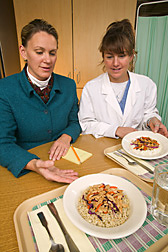Whole-Grain Foods’ Fat-Fighting Role Scrutinized
|
|
Your annual physical may include blood tests for several telltale indicators of your health. And one of those may be your level of triglyceride, a fat, or lipid, that needs to be kept in check.
Whole-grain foods—crunchy whole-wheat toast or hearty brown rice, for instance—are already known to help keep triglycerides at levels healthful for your heart. Now, a study by Agricultural Research Service scientists in California provides new insight into how whole grains might do that.
Triglycerides and other lipids are transported throughout the bloodstream as a component of particles called “lipoproteins.”
Why We Need Lipoproteins
“Lipoproteins are the body’s means of moving lipids to muscles, where they’re used for energy, or to fatty tissue, where they’re stored as reserves,” says ARS chemist Nancy L. Keim. She designed and led the whole-grain investigation at the agency’s Western Human Nutrition Research Center in Davis, California.
|
|
“Lipoproteins occur in a range of densities,” says Keim. Healthcare professionals generally agree that high-density lipoproteins are good, while low-density lipoproteins are bad.
Keim and colleagues explored the effect that whole-grain foods and refined grains (think: white bread) have on lipoproteins. They looked at both the lipids and the proteins that combine to make up lipoproteins.
The 10 women, age 20 to 45, who volunteered for the study each completed a whole-grain regimen and a refined-grain stint. During the first 3 days of the whole-grain phase, the volunteers ate six to eight servings of whole-grain foods a day, on average. Those foods included a whole-grain cereal at breakfast, pearled barley with supper, and rye crackers as a bedtime snack.
While on the refined-grain regimen, the women ate foods such as a refined-grain cereal at breakfast, white rice with their evening meal, and graham crackers for the after-supper snack.
On the fourth and final day of both stints, the women came to the nutrition center to eat breakfast. They provided blood samples before their meal and at three intervals afterwards.
Using an ultracentrifuge to spin the blood samples, the researchers separated out the lipoproteins. Their analyses showed that volunteers’ very low-density lipoproteins (VLDL) contained significantly more triglycerides following the refined-grain test breakfast than after the whole-grain test breakfast.
Also, after the refined-grain test meal their VLDLs had significantly higher levels of a worrisome protein called “apolipoprotein CIII” (apoCIII).
“In medical studies, apoCIII has been associated with high levels of triglycerides and increased risk of heart disease,” notes Keim. It’s also been shown to interfere with the work of an enzyme called “lipoprotein lipase.” Lipoprotein lipase removes triglycerides from VLDLs so that the triglycerides can be used or stored.
“VLDLs are naturally rich in triglycerides, so you want the lipoprotein lipase—your triglyceride-removing mechanism—to be very efficient,” says Keim. “If the apoCIII protein on your VLDLs slows down the lipoprotein lipase, triglycerides may spend more time in your VLDLs instead of where they belong—in your muscles or fat tissue. The longer the triglycerides remain in your VLDLs, the more likely they are to be oxidized or to infiltrate your arteries. Neither outcome is good.”
|
|
Strive for Three
The California study is likely the first in humans to demonstrate an association between a refined-grain regimen and higher levels of the problematic apoCIII protein in volunteers’ VLDLs.
A follow-up study, longer and with more volunteers (plans call for signing up about 40 men and women to participate), is scheduled to begin this year.
Keim conducted the study in collaboration with William F. Horn and Manuel C. Tengonciang, Jr., of the Davis center, and Tara A. Hembrooke, formerly at the center, and reported preliminary findings at the 2005 meeting of the Federation of American Societies for Experimental Biology.
America ’s dietary guidelines recommend that we eat at least three servings a day of whole-grain foods. But about 95 percent of us eat less than a single serving a day.
Maybe results of Keim’s investigations will be just the nudge we need to ensure that we get our daily measure of these nourishing grains.—By Marcia Wood, Agricultural Research Service Information Staff.
This research is part of Human Nutrition, an ARS National Program (#107) described on the World Wide Web at www.nps.ars.usda.gov.
Nancy L. Keim is with the USDA-ARS Western Human Nutrition Research Center, One Shields Ave., Davis, CA 95616; phone (530) 752-4163, fax (530) 754-4376.
"Whole-Grain Foods’ Fat-Fighting Role Scrutinized" was published in the March 2006 issue of Agricultural Research magazine.










